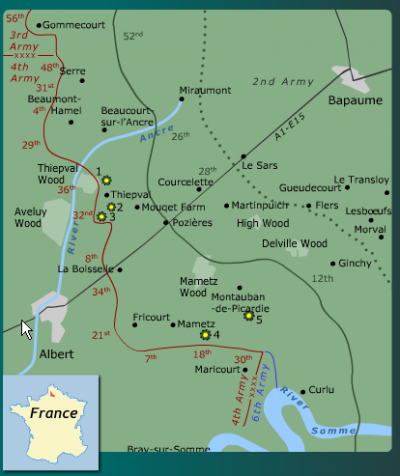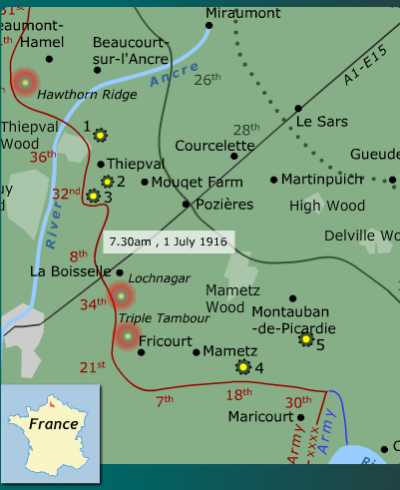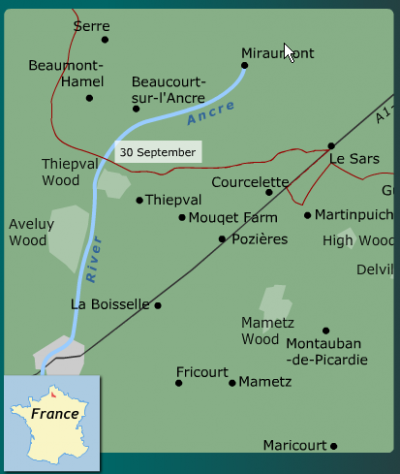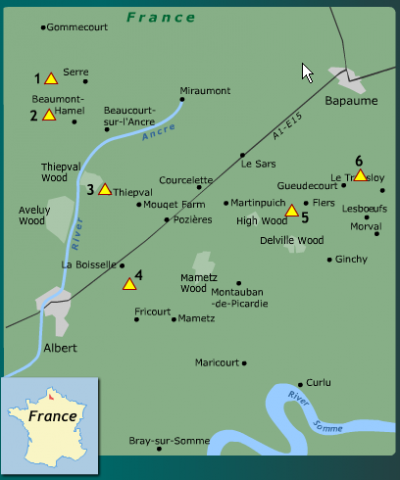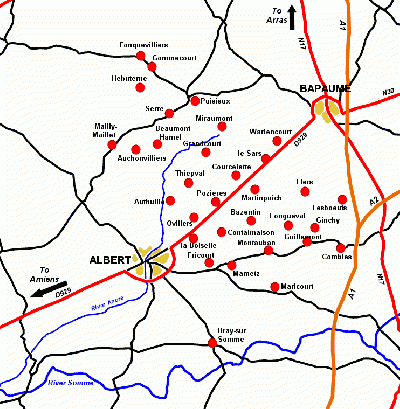Somme 1916 German strong points
The terrible battle of the Somme 1916. Here are the latest news facts of this battle.
The invasion of 1914 left great tracts of French and Belgian territory in German hands. The expulsion of the invader dominated Allied strategy, but it meant attacking when developments like machine-guns and heavy artillery favoured the defender. The spot chosen for the main offensive of 1916 was where the British and French armies met, north of the River Somme. But the massive German attack on the French at Verdun in February had increased pressure on General Sir Douglas Haig, the British commander in chief, to attack without delay.
The main attack would be by General Sir Henry Rawlinson's 4th Army. He favoured the gradual, 'bite and hold' approach. Haig demanded a bolder assault, quickly taking Bapuame then swinging north to 'roll up' the German line. Lieutenant General Sir Hubert Gough's Reserve Army would exploit any breakthrough. General Sir Edmund Allenby's 3rd Army would create a diversion by attacking Gommecourt.
Defence
The terrain of the Somme battlefiels - rolling chalk uplands with nucleated villages and a sprinkling of big farms - offered many advantages to the defender.
The German first position, itself containing a number of fighting trenches linked by communication trenches and protected by barbed wire, was carefully sited to dominate the slopes.
Numerous deep dugouts, resistant to hits by most Allied guns, has bee mind deep into the chalk. A second postion had been prepared just behind the first, and a third, further back was in process of construction.
German strong points:
- Schwaben redoubt
- Wonder work
- Leipzig salient
- Pommiers redoubt
- Glatz redoubt
Bombardment
Henry Rawlinson hoped to destroy the first position with a week-long pre-battle bombardment in which over 1,700,000 shells were fired.
The bombardment was apparently mightily impressive, but it failed to destroy many deep dugouts and left sections of wire inadequately cut.
Eight large and eleven small explosive-filled mines were dug beneath German trenches.
The most important of them were beneath Hawthorn Ridge Redoubt at Beaumont Hamel, just south of La Boisselle (now Lochnagar Crater), and three in the 'Triple Tambour' near Fricourt.
- Hawthorn Ridge
- Lochnagar Crater
- Thriple Tambur
First Day of the Somme
There was widespread confidence that the bombardment had done so much damage to the German first position that the infantry, moving steadily in lines, would simply have to occupy shattered trenches.
It soon became clear, when the attack began at 0730 on 1 July, that the defenders were still in good heart.
There were few significant gains north of the main Albert-Bapaume road. Just north of Thiepval, the 36th Ulster Division took the Schwaben Redoubt but poor progress to the flanks meant that it could not be held. South of the Albert-Bapaume road the picture was less gloomy. Although La Boisselle itself held out - the attacking 34th Division lost 6,380 of its soldiers, the heaviest toll for a single division on the Somme - ground was seized to its immediate south. Fricourt was almost encircled, and both Mametz and Montauban were taken.
The French, on the British right, made good progress, taking Curlu. The British army suffered 57, 470 casualties that day, 19,240 of them were killed or died of wounds. This shocking total (compared with perhaps 10,000 to 12,000 Germans killed or wounded during the bombardment and on the battle's first day) reflected many failings: lack of experience; unenterprising infantry tactics; overconfidence in the preliminary bombardment; and a 'creeping barrage', which moved too far ahead of the attacking infantry for them to keep pace with it.
Pressing the Attack
Douglas Haig visited Rawlinson on 2 July and directed him to renew pressure in areas where he had done best on the 1 July.
He then made the Reserve Army (later redesignated 5th Army) responsible for the sector north of the Albert-Bapaume road.
Rawlinson would not be able to assault the German second position until he had cleared the substantial woods lying in front of the newly-captured ground.
The most obdurate of these obstacles was Mametz Wood.
Its capture contributed to the mauling of 38th Welsh Division, fighting its first battle.
Rawlinson determined to attack the German second position early on 14 July.
This time his guns - concentrated against a much narrower sector than they had been on 1 July - would fire a short 'lightning bombardment'.
The infantry, who had moved up under cover of darkness, would go in just before first light.
The attack of 14 July proved remarkably successful, but narrowly failed to take the dominant High Wood.
Ghastly by Day, Ghostly by Night
Although there were isolated successes in this phase of the fighting, like the capture of Ginchy by 16th Irish Division on 9 September, Haig came under increasing political pressure to break the costly stalemate that seemed to have set in.
He decided to use a newly developed weapon - the tank (its title derived from the codename of 'water-tanks' coined in an effort to preserve secrecy) to fight the battle for Flers-Courcelette, a major offensive by 4th Army south of the main road.
On 15 September, when the battle began, only 49 tanks were available, and of these only 32 actually reached the start line for the attack. Rawlinson had decided to split them up across the whole of the attack front, rather than to concentrate them in key sectors.
The results of the first day's fighting were impressive. High Wood was taken by the Londoners of 47th Division, while the Scots of 15th Division took Martinpuich and the Canadians seized Courcelette. Twice as much ground had been taken as on 1 July, and for half the cost in casualties. German losses had been appalling, there was no wholesale breakdown in morale, and no clean breakthrough.
Battle of Morval, 25-28 September 1916
In the aftermath of the battle of Flers-Courcelette, a number of operations were undertaken in specific sectors. On 25-28 September the British took Morval, Lesboeufs and Guedecourt. This fighting showed just how much tactics had improved since 1 July. The artillery bombardment was heavier than that delivered on 15 September, but on a narrower front. And the infantry generally managed to keep pace with the creeping barrage, often arriving in German trenches before their defenders had emerged from shelter to man them effectively.
Battle of Thiepval Ridge, 26-30 September 1916
In Reserve Army's sector, Thiepval - a village on a spur dominating the Ancre valley - still held out. It had been a 1 July objective. The Battle of Thiepval Ridge, launched on 26 September, was the largest action so far undertaken by Reserve Army. Its centrepiece was the capture by the 18th Division of Thiepval village on 27 September, and the Schwaben Redoubt the next day. The division had performed well at Montauban on 1 July and had since been honed by its talented commander, Major General Ivor Maxse. His division was able to attack directly along the ridge from the south, because the German position to the east of Thiepval had been weakened by an Australian assault on Mouquet Farm. In early October 4th Canadian Division made significant progress north-east of Thiepval, with another example of slick tactics.
End of the Somme, November 1916
Worsening weather and the physical destruction of the battlefield made life increasingly hellish for attackers and defenders alike. Nonetheless, October and November saw two last attacks. In the Battle of the Transloy Ridges, 4th Army made poor progress. But 5th Army (formerly Reserve Army) had more success in the Battle of the Ancre, when 51st Highland Division took Beaumont Hamel and the 63rd (Royal Naval) Division took Beaucourt. This was a heavy blow for General Erich Ludendorff, the German commander. By contrast, Haig attended the inter-Allied conference with a recent success to his army's credit.
In all, the Allies had advanced some seven miles on the Somme. Bapaume, a first week objective, remained in German hands. Historians agree that the cost to the Allies was almost 624,000 casualties - nearly 420,000 of them British. The Germans counted their casualties differently, with estimates ranging from 680,000 - exceeding the Allied total - to 500,000.
One German officer called the Somme the 'muddy grave of the German field army'. Recognition that Germany could not win the war on the Western Front in 1917 influenced the initiation of unrestricted submarine warfare, which itself brought America into the war. The Somme - Britain's costliest battle - was a severe blow to the nation's self-confidence. The 'Memorial to the Missing' at Thiepval, and the many cemeteries show something of the battle's human cost. Yet the British army after the Somme was better trained and more experienced than before it. Indeed, it has been argued that the battle was an essential precondition to Allied victory in 1918. My head inclines me to agree: but it is difficult to visit the battlefield without being struck by the sheer scale of suffering, and as I grow older I find the emotional burden of the place ever harden to sustain.
Tour of Battlefield
1. Sheffield Park
1 July, 1916 Serre was attacked from the east edge of this wood by two battalions - known by their familiar titles of the Sheffield City Battalion and the Accrington Pals. They went forward under German machine-gun and artillery fire, the latter so accurate and consistent that the shell-bursts it gave the impression of 'a thick belt of poplar trees'. The two battalions lost 38 officers and 1069 men. A few British soldiers actually managed to get into Serre: their bodies were found there when the British briefly entered the village that autumn. It was not finally taken till the Germans pulled back from the whole area in early 1917.
Now Visitors can sometimes see iron harvests of shells left by farmers. The present wood still reveals shell-holes and the course of trenches. A line of small cemeteries in the fields east of Serre, containing dead who were buried close to where they lay, roughly marks the position of the German wire. Dead collected later on lie in two huge 'concentration cemeteries' on the Serre road.
2. Sunken lane west of Beaumont Hamel
1 July 1916 This was the start line for the two leading companies of 1st Lancashire Fusiliers, most of whom had already fought in Gallipoli. The first objective was the village of Beaumont Hamel. The village is dominated by Hawthorne Ridge, where a mine was exploded at 7.20. Some British soldiers raced for the crater but the Germans beat them to it. The main attack failed: the fusiliers were machine-gunned as they came up out of the sunken lane. Seven officers and 156 men were killed, with 14 officers and 298 men wounded.
Now A memorial commemorates not the 1 July attack, but 1/8th Battalion The Argyll and Sutherland Highlanders, who helped take the village on 13 November 1916. Warning tapes on the eastern edge of the lane mark the position of a bunker which collapsed during ploughing in 1999. The German trenches ran along the edge of the trees to the east: a small cemetery between the sunken lane and the German position marks the spot in No Man's Land where many of the attackers were killed.
3. The Thiepval Memorial
1 July 1916 The memorial stands on one of the strongest parts of the German front line, which was attacked by 32nd Division on 1 July 1916 and held by 99th Reserve Infantry Regiment. Thiepval was eventually taken by 18th Division on 26 September 1916 in a well-planned operation commanded by Major General Ivor Maxse.
Now All British and Dominion dead in both world wars have either a known grave or a memorial. The Thiepval Memorial commemorates over 70,000 British and 830 South African officers and men killed in 1916-17 on the Somme. Over 1,000 of those mentioned on the memorial have since been found and so have known graves. The Memorial, standing approximately 150 feet high, was designed by Sir Edwin Lutyens and is the largest of the Memorials built by the Imperial (now Commonwealth) War Graves Commission. The Memorial was built to symbolise the Allied effort. It is designed to fly a British and a French flag, and the cemetery adjoining it contains 300 British and 300 French dead.
4. Lochnagar Crater
1 July 1916 The mine contained 66,000lbs of ammonal in two charges 55 feet below the surface. The mine was blown at 7.28 on the morning of 1 July, and was the largest of the mines exploded: the explosions constituted what was then the loudest man-made sound in history, and could be heard in London. The mine created a crater 90 yards across and 70 feet deep, with a lip 15 feet high. The sector was attacked by the 34th Division, a New Army Division consisting of Tyneside Irish and Tyneside Scottish battalions. It lost 6,380 officers and men that day, and was the hardest-hit British division.
Now It is the largest surviving mine crater on the Western Front, although some of the mines exploded beneath Messines Ridge in 1917 contained more explosive. It is the scene of a moving commemoration at 7.30am, zero hour, on 1 July each year. The bodies of British soldiers that were found have been buried in Commonwealth War Graves Commission cemeteries.
5. New Zealand Memorial
15 September 1916 The Memorial stands on the ridge between High Wood and Delville Wood, ground taken in the first ever tank attack on 15 September. There were 49 tanks in France, and 32 reached the start line for the attack - shocked Germans described them as 'the devil's chariots'. This attack, officially the Battle of Flers-Courcelette, made good progress, but ran out of momentum in the German third position, with autumn at hand and a blighted battlefield standing between the attackers and their reinforcements.
Now Australian and New Zealand troops, eventually combined into the Australian and New Zealand Army Corps (ANZAC) played a distinguished part on the Somme. The New Zealand Division, fighting as part of XV Corps, lost 2,500 men capturing the ground on which its Memorial stands, and the words on the plinth 'From the Uttermost Ends of the Earth' emphasise the sheer distance these young men had travelled to die on the Somme. There is also a South African Memorial and museum nearby, and a visitor centre on its southern edge.
6. Newfoundland Memorial, Gueudecourt
12 October 1916 The Caribou here commemorates the Newfoundland Battalion. This battalion had probably suffered more losses in its attack, on Beaumont Hamel, on 1 July than any other battalion, and was still on the Somme at the battle's end, capturing a nearby trench on 12 October. This was the scene of the last burst of fighting on the Somme, officially the Battle of Transloy Ridges, on 7-20 October. By this time the weather had broken and there was a sea of mud behind the British trenches; frost bite and trench foot were running at about 1000 cases per week.
Now The Thiepval memorial, which stands on the 1 July front line, is visible to the west. Getting from Thiepval to this spot, now a 15 minute drive, had cost the British army over 400,000 men killed, wounded and missing. Just south of the village is the AIF (Australian Imperial Force) which contains 3,450 graves, nearly two-thirds of which are unknown soldiers. Buried there is Second Lieutenant Ernest Shephard of the Dorsetshire Regiment whose diaries were published as A Sergeant Major's War.
Source
BBC 2006 History Channel, More
See also
External
- BBC Somme 1916
- Battlefields: [1]The following links on the Somme:
- Albert, Albert was the main town behind the lines for the Allies nearest to the 1916 Somme battlefields.
- Ancre, The Ancre is a river which runs through Albert and then south-east to eventually join the River Somme near Corbie. Further upstream, however, its course is to the north of Albert, and it runs by the villages of Beaucourt, Authuille and Aveluy.
- Beaumont Hamel, The village of Beaumont Hamel was one of the fortress villages located just behind the German lines on the 1st of July 1916.
- Delville Wood, Delville Wood was sometimes known as Devil's Wood, and the fighting there during the battle of the Somme was particularly ferocious. The majority of the wood was eventually taken by South African soldiers on the 15th of July 1916, and they held on grimly during numerous German counterattacks for six days, until they were relieved.
- Newfoundland, This park, located near Beaumont Hamel, is one of only a few sites on the Western Front where the ground remains largely untouched from when the First World War ended.
- Pozieres, This small village is located on a ridge of high ground between Albert and Bapaume, and thus had great strategic importance to both the Allies, who wanted to take it as part of their advance, and the Germans who clung determinedly onto it.
- Serre, Serre was one of the strongly fortified villages held by the Germans at the beginning of the Battle of the Somme. The village, about five miles north of Albert, marked the most northern point of the main attack on the 1st of July 1916 (although there was a subsiduary attack at Gommecourt, a mile or so further north).
- Thiepval from the Battlefields of the Somme.
- Ulster Tower, The Ulster Tower is a memorial to the men of the 36th (Ulster) Division. It is located very near to the famous Schwaben Redoubt (Feste Schwaben) which the Division attacked on July 1st, 1916. The Schwaben Redoubt was a little to the north-east of where the tower stands, and was a triangle of trenches with a frontage of 300 yards, a fearsome German strongpoint with commanding views.
Internal
- Thiepval, Remembrance Memorial.
Reference
- ↑ Battlefields.co.uk website World War One Battlefields is the website made by Alan Jennings, who lives in Wiltshire.
